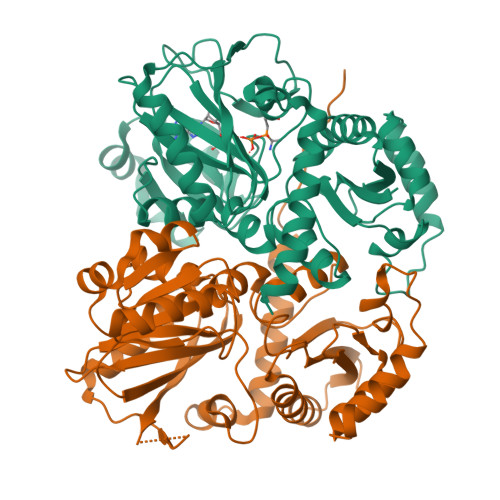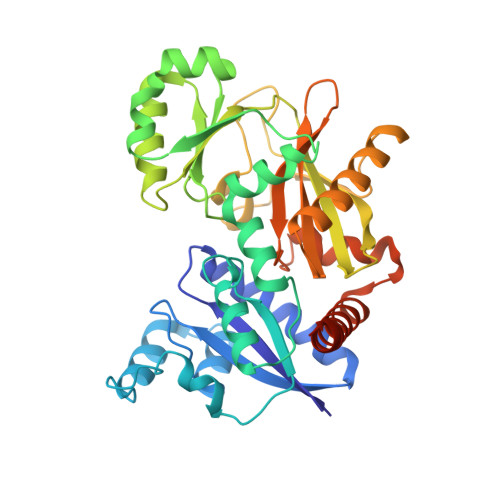Enzymes of vancomycin resistance: the structure of D-alanine-D-lactate ligase of naturally resistant Leuconostoc mesenteroides.
Kuzin, A.P., Sun, T., Jorczak-Baillass, J., Healy, V.L., Walsh, C.T., Knox, J.R.(2000) Structure 8: 463-470
- PubMed: 10801495
- DOI: https://doi.org/10.1016/s0969-2126(00)00129-5
- Primary Citation of Related Structures:
1EHI - PubMed Abstract:
The bacterial cell wall and the enzymes that synthesize it are targets of glycopeptide antibiotics (vancomycins and teicoplanins) and beta-lactams (penicillins and cephalosporins). Biosynthesis of cell wall peptidoglycan requires a crosslinking of peptidyl moieties on adjacent glycan strands. The D-alanine-D-alanine transpeptidase, which catalyzes this crosslinking, is the target of beta-lactam antibiotics. Glycopeptides, in contrast, do not inhibit an enzyme, but bind directly to D-alanine-D-alanine and prevent subsequent crosslinking by the transpeptidase. Clinical resistance to vancomycin in enterococcal pathogens has been traced to altered ligases producing D-alanine-D-lactate rather than D-alanine-D-alanine. The structure of a D-alanine-D-lactate ligase has been determined by multiple anomalous dispersion (MAD) phasing to 2.4 A resolution. Co-crystallization of the Leuconostoc mesenteroides LmDdl2 ligase with ATP and a di-D-methylphosphinate produced ADP and a phosphinophosphate analog of the reaction intermediate of cell wall peptidoglycan biosynthesis. Comparison of this D-alanine-D-lactate ligase with the known structure of DdlB D-alanine-D-alanine ligase, a wild-type enzyme that does not provide vancomycin resistance, reveals alterations in the size and hydrophobicity of the site for D-lactate binding (subsite 2). A decrease was noted in the ability of the ligase to hydrogen bond a substrate molecule entering subsite 2. Structural differences at subsite 2 of the D-alanine-D-lactate ligase help explain a substrate specificity shift (D-alanine to D-lactate) leading to remodeled cell wall peptidoglycan and vancomycin resistance in Gram-positive pathogens.
Organizational Affiliation:
Department of Molecular and Cell Biology, The University of Connecticut, Storrs, CT 06269-3125, USA.





















